#scythian mythology
Explore tagged Tumblr posts
Text
ARTIMPASA // SCYTHIAN GODDESS OF WARFARE, SOVEREIGNTY, PRIESTLY FORCE, FECUNDITY, VEGETATION & FERTILITY
“She was a complex androgynous Scythian goddess of fertility who possessed power over sovereignty and the priestly force. Artimpasa was a goddess of warfare, sovereignty, priestly force, fecundity, vegetation and fertility. The cult of Artimpasa was performed by the Anarya, who were powerful transvestite priests from the most noble families affiliated to an orgiastic cult of the goddess.
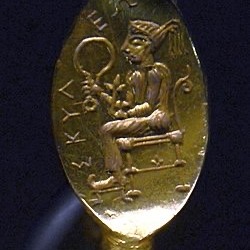
0 notes
Text
A Scythian goddess on Apulian vases

These are five vases likely showing the elusive Scythian ancestral goddess.
I love the floral imagery, but I’m also frustrated that I can’t find much information about the tendril-limbed female figures. I’m fairly certain that these images, aside from the siren, depict the Scythian ancestral goddess, but I can’t find any art historians who specifically discuss the figures. I’ve found several articles that talk about the vases in general, but they only focus on the flowing vines and the main scenes, not on the likely Scythian deity herself.

Apulian red-figure oinoche, about 350-320 BCE. Photo by courtesy of Dr. Matthias Recke, University of Giessen, Antikensammlung Museum. Photo via Peter on Flickr.
This vase could also be a siren, the lovely singers of Homeric fame. While the other Scythian goddesses only have wings, this woman has bird feet. Sirens were bird-bodied women to ancient Greek artists. However, this siren is unusual as her tail feathers curl out on either side of her, like the Scythian ancestral goddess’s tails do.


Apulian Red-Figure Loutrophoros about 330 B.C. Attributed to the Painter of Louvre MNB 1148 (Greek (Apulian), active 350 - 330 B.C.) Info from Getty Museum.
This woman has wings, a calathus on her head like the Vergina mosaics of the Scythian goddess, and a dress like the Carytids in the Thracian Tomb of Sveshtari, Bulgaria, except her upper body is topless. The lower part of the vase shows the mourning of Niobe.
The figure is described but not identified in: Occasional Papers on Antiquities, Greek Vases In The J Paul Getty Museum. An Apulian Loutrophoros Representing the Tantalidae. By A.D. Trendall. 1985. Pages 140-41, fig, 14.


Winged woman with tendrils, likely the Scythian goddess. Apulian red-figure vase, about 340 BCE, Varrese Painter; Antikensammlung Kiel, inventory number B 724. Picture taken by Marcus Cyron via Wikipedia.
This woman also has wings, a calathus on her head, and the distinctive curling chiton dress like other Scythian goddess figures wear. She’s mentioned in the article “Half-Human Half-Vegetal Hybrids in Eastern Mosaics” which does talk about Scythian goddess imagery, but the author doesn’t specify that this is an image of the Scythian goddess.


Likely Scythian goddess, Baltimore painter, loutrophoros with wedding scenes, about 325-320 BCE. Matera, Museo Archeologico Nazionale. Photos via Saiko on Wikipedia.
Our next goddess has a different style dress, and much more elaborate tendrils— but she also has wings and calathus on her head. It’s interesting that most of these goddesses have bare toros, as she Scythian goddess is usually shown with a full dress.

We also have a confirmation that this imagery is related to the Scythia goddess, in an article on her imagery:
“The female winged deity with lower part of the body resembling a palmette or acanthus leaves is a widespread image on Apulian vases. Two characteristic examples are the “Niobe” amphora (4th century BCE) from Naples, featuring an aedicula stepping on a base decorated with several such figures (20) Fig 7 and a case which was sold at Christie’s in 1979, dated to the last decades of the 4th century BC.” (Valeva 1995.)
This article could be referring to the Getty vase, as they're both showing scenes with Niobe. Image from Baggio 2013.
The figures are also described in a chapter about Scythian goddess imagery, by Ustinova, on page 103:
“In Italy, the chthonic symbolism of this goddess was conspicuous: on an amphora from Neapolis, featuring a Niobids-scene, Niobe is portrayed in a naiskos, its foundation decorated with a group of tendril-limbed winged figures, calathi on their heads (Curtius 1958: fig. 33).
Update: I found one more example of this motif on a vase here.
Sources.
Valeva, Julia. “Valeva-1995 The Sveshtari Figures (An Attempt to Specify Several Hypotheses).” Thracia 11, Studia in honorem Alexandri Fol, Sofia. (1995): n. pag. Print.
DERWAEL, Stéphanie. “Half-Human Half-Vegetal Hybrids in Eastern Mosaics.” Journal of Mosaic Research, no. 16, 2023, pp. 89–110, https://doi.org/10.26658/jmr.1376718.
Heuer, Keely. “Tenacious Tendrils: Replicating Nature in South Italian Vase Painting.” Arts, vol. 8, no. 2, 2019, p. 71, https://doi.org/10.3390/arts8020071
Baggio, Monica. “Sistemi Di Immagini, Sistemi Di Oggetti Le Loutrophoroi Del Pittore Di Baltimora.” Cahiers « Mondes Anciens », no. 4, 2013, https://doi.org/10.4000/mondesanciens.1072.
Ustinova, Yulia. The Supreme Gods of the Bosporan Kingdom: Celestial Aphrodite and the Most High God. Boston: Leiden, 1999.
#twin-tailed siren#mistress of animals#ancient greek art#mistress of beasts#scythian goddess#apulian vase#red figured vase#potnia theron#greek mythology#greek myth art#sirens#greek art#ancient art
262 notes
·
View notes
Text
Athena and Perseus catch up
Athena: Does it upset you that your grandson Heracles had intercourse and three children with a snake woman who resembles a gorgon or do you not mind?
Perseus: Wha- Who the fuck starts a conversation like that? I JUST SAT DOWN!
#greek mythology#athena#perseus#medusa#gorgon#Scythia#scythian dracaenae#mythology is fun to learn about because there is a lot of weird detailed shit in it
47 notes
·
View notes
Text
"Although Circê also, it is said, devoted herself to the devising of all kinds of drugs and discovered roots of all manner of natures and potencies such as are difficult to credit, yet, notwithstanding that she was taught by her mother Hecatê about not a few drugs, she discovered by her own study a far greater number, so that she left to the other woman no superiority whatever in the matter of devising uses of drugs. She was given in marriage to the king of the Sarmatians, whom some call Scythians, and first she poisoned her husband and after that, succeeding to the throne, she committed many cruel and violent acts against her subjects. For this reason she was deposed from her throne and, according to some writers of myths, fled to the ocean, where she seized a desert island, and there established herself with the women who had fled with her, though according to some historians she left the Pontus and settled in Italy on a promontory which to this day bears after her the name Circaeum"-Bibliotheca Historica

so the issue was the cruel acts specifically too lmao
#greek mythology#ancient greece#ancient greek mythology#circe#Scythians#Sarmatians#hecate#tyrant circe
19 notes
·
View notes
Text
The priestess of Artemis in Tauris
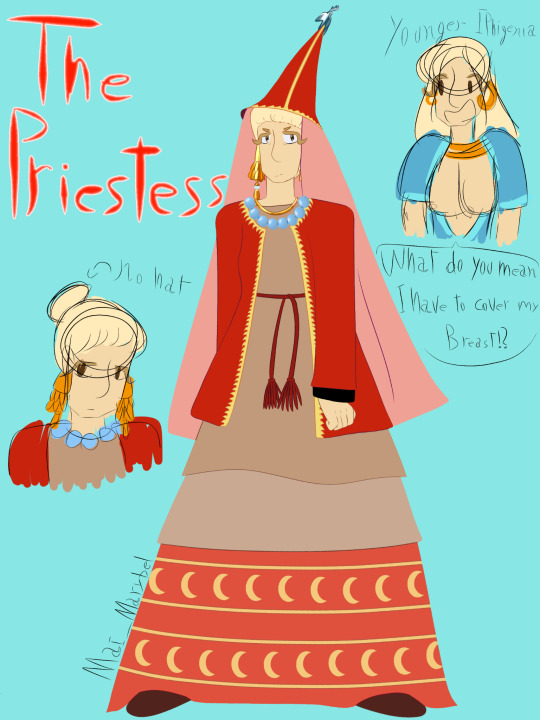
Aaahhh priestess Iphigenia you will always be loved by me
When making my design I try to be more, emmm historically accurate? Idk if that would the word, but y'know I try to design by how they would have actually dress like. Since most Greek mythology happens in the Mycenaean period, that's how I draw most of my interpretations, but it gets more tricky when it comes to the "barbarian" characters. Iphigenia is Greek but she acted as a priestess in a foreign land for over 17 years, so she probably dressed like them. Unfortunately, the ppl who would have been alive in that place during that time period didn't really leave records of his they dressed, so I went for the next best thing and dressed her in Scythian clothing.
It's a good thing their priestesses outfits seem to be mostly red, since it helps me give a direct contrast with the blue she dressed in back at home.
She's over 30 in this drawing and it's very tired of everyone's bullshit.
I will later make a post comparing this design with an old design I made of her
9 notes
·
View notes
Note
What is your favorite ancient population? Sorry for the question but I was curious about this :'D
If we're talking Ancient as in Bronze Age :

I'm currently obsessed with the EPIC concept music! (The Horse and the Infant- EPIC: The Troy Saga)
#Also is thanks to Mycenean Greece and people from greece in general we have writings of other ancient civilizations like the Scythians#I like they weird mythology too
28 notes
·
View notes
Text




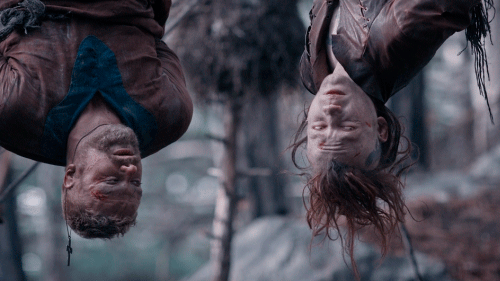

#the scythian#the last warrior#marten#fantasy#I feel the mood#mythology#thor#loki#paganism#pagan#aleksandr kuznetsov#Скиф#александр кузнецов#фэнтези
13 notes
·
View notes
Text
As you may have seen @katerinaaqu and I have been discussing about a head canon of hers, tatted Odysseus.
For a while we searched for Scythian tattoos as they are the closest society that allowed tattoos, we weren´t sure if in Mykenean Greece they were frowned upon but in classical Greece they were (criminals, shady or barbaric people wore them).
So to make it plausible we came up with this idea: in the middle of the Troyan war in a resupply day, Menelaus and Agamemnon find Odysseus been tattooed an olive tree by a Scythian, perplexed by this they told him that it was a nothing a king should do, shady look.
But Odysseus told them it was a memory of his home of Penelope and Telamachus, that at least if he died there it would have died with his family. Also is a display of Ody´s more flamboyant personality traits, he didn´t tattoed a small olive or branch, nonono, he tattoed a whole tree!.
As the real design is composed of branches inspired by Scythians tattoos of deer´s antlers, (the lack of trees in the steppes prevented them from forming a more floral and plant style; being deer's antlers where we find more plant 'like designs),

The olive flowers are simplifications of the actual flower,
Flowers for my beautiful wife, whom I longed for, for years

The leaves are blackouts of the originals and the olives are also simplifications.
The sweet fruit of my dear Telemachus whom I never saw growing
The images below are the sketches I made for having an idea of the placement and elements we wanted to include.
We chose the upper arm as it was more concealable and only be fully revealed to Penelope.
As you can see there´s a swallow drawing, it has it reasons, swallows (Hirundo rustica) have a year migration and came back to Europe and Greece in spring, being heralds of the season and all that entails (hope, regrowth, fertility...) but the most important attributes for us were; (Athena transforms into a swallow and flies away from Telemachus in the Odyssey). Also it is mentioned that the chord of Odysseus's bow "sang like a swallow" when he used it to kill the suitors symbolizing his homecoming.
Swallows have always been linked to journeys specially to homecoming. They idea was of one swallow (Odysseus) but swallows are paired and as a small reminder, the biggest and most ornate is Penelope, fully in flight and more artistically and Odysseus is the one below more naturalistic as he is lesser in his eyes than her. The swallows are more linear and not painted as it also seems more secretive and blank spaces for everyone except him (So he can say everything I have been writing to her)
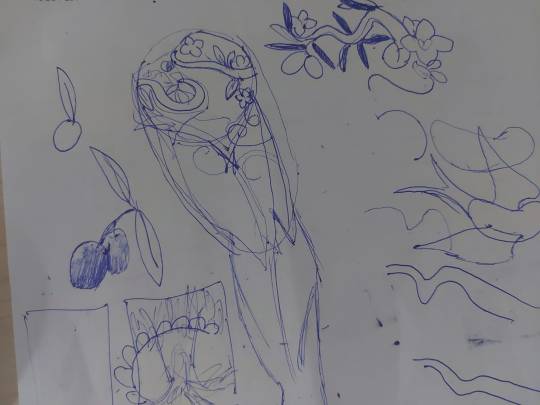

These is the final rendition of the idea!
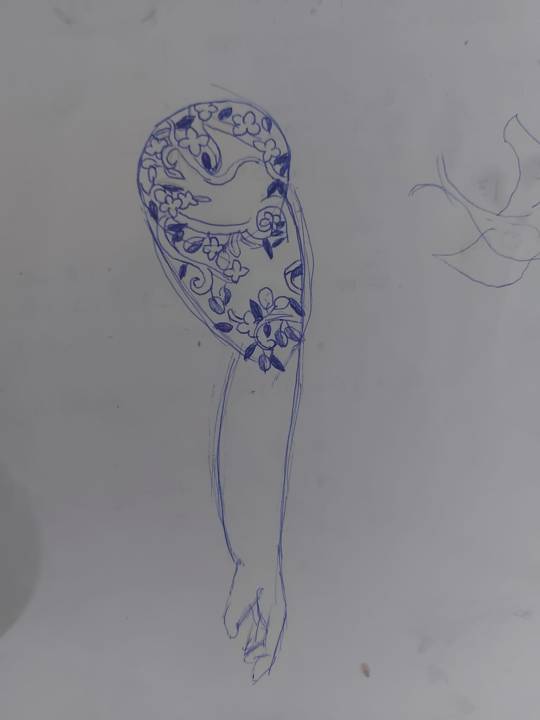
I hope you have enjoyed and that it becomes your new headcanon!
@katerinaaqu thank you so much for everything! It has been a pleasure!
#@katerinaaqu#@aaronofithaca05#headcanons#olive tattoo#olive#flowers#branches#inspired Scythian tattoo#greek mythology#odysseus#the odyssey#homer#swallows#tattoos with meaning#sketches#aaron´s doodles#penelope#telemachus#odysseus x penelope#odysseus the sailor#odysseus the master mariner
38 notes
·
View notes
Text
Terrible Fic Ideas #60: The Old Guard, but make it Percy Jackson
I was not intending on falling headfirst into another fandom. Nor was I intending to come up with another crazy PJO crossover that somehow manages not to be crack, but I discovered The Old Guard last weekend and this is the end result.
Or: What if, post-movie, the Guard decided to lay low at the one place Merrick's people could never find them: Camp Half-Blood?
aka the Maps for the Getaway fic
Bear with me:
For most of history, "the cradle of western civilization" has been in Europe, as befitting a throughly European idea. But Europe is a big place - and even bigger when you don't have modern transportation to fall back on. A common rule of thumb for medieval travel goes something like 1 day sailing = 7 days on horseback = 21 days walking.
Plus sending satyrs to scope out likely schools is a lovely idea in an era with compulsory public education, but less likely to work in an era where even universities are few on the ground.
All that being said, I imagine it would have been ridiculously easy for demigods to slip through the cracks and never make their way to CHB or CJ, not once suspecting they were anything other than fully human. This is especially true of demigods without spectacular active powers like creating hurricanes or summoning the dead.
As there's no canonical reason why the members of the Old Guard are immortal, there's no reason they can't be demigods who slipped through the cracks, died, and became immortal because of their divine ancestry. It's a rare quirk of genetics that shows up only in 1 in a 10,000 demigods, most often in those who lack any active powers and show only the passive traits of their divine parent - and, therefore, have no idea that they're demigods at all until much, much later in the game.
For the purposes of this fic: Quỳnh and Lykon are descended from southeast asian and subsaharan pantheons of which modern historians have only limited knowledge. Andy is the daughter of Dyḗus, the PIE sky god considered to be equivalent to Zeus, and thus is something like Zeus' stepdaughter. Nicky is the only child of Neptune born in the last two millennia, Joe the son of Apollo in his Greek incarnation, and Nile the daughter of Mars. I went back and forth for possible divine parents for Booker, but ultimately decided to make him a son of Dionysus in this AU. None of them exhibit anything that might be called a power, but have certain talents and personality traits that mark them distinctly as of divine descent.
Just imagine it:
Following Merrick, the Guard needs to lay low. They have many safe houses but no way of knowing how many are compromised. In the end, they decide to go to the one place Merrick can be assured not to find them: Camp Half-Blood.
They get halfway to Ramsgate before realizing the UK probably no longer counts as "the cradle of Western civilization". With a little bit of divine intervention, they find their way to Long Island.
CHB is not unused to people showing up bloody on their doorstep, but most campers have never seen one adult demigod, let alone five. The fact that two of them are Roman and one predates Zeus himself is startling, as I picture this happening in the summer immediately after TLO, before Hera kidnaps Percy.
There's some tension, partly because of the Greek/Roman thing, partly because some campers are bitter these well-trained adults didn't show up to help during the Battle of the Labyrinth/Battle of Manhattan. (The answer - that they just didn't know Kronos was rising - doesn't help much, but the masterclasses they give on various fighting techniques do.)
Percy spends more time at CHB during the next few months than he ever has - after all, who knows when he'll next get to see a non-monstrous half-brother? Nicky may be the son of his father's Roman incarnation - the only one born since Sextus Pompeius to hear him tell it - but he's still family. An ideal big brother really. This does not keep Percy from being kidnapped or the events of HOO from happening, but it does mean there are more people keeping an eye out for him, and when the Argo II runs into trouble in Europe a few people they can call for backup.
But otherwise I have very little plot for this and a lot of scenes of a long few months where CHB and the Guard interact, but then largely go their separate ways until the kids need to phone a friend. This includes: 1) Booker spending a lot of time with his father and remaining half-brother, which gives him both family and the therapist he needs. It's not a magical fix-all, but it starts the path of healing; 2) Nile freaking out over the demigod thing as well as the immortality, but finds comfort in her Ares half-siblings, and generally realizing that while she may have lost her mortal family she never has to be alone, even if she decides being a member of an immortal army isn't for her; 3) Andy teaching all the children all the weapons, because as much as he hates baby demigods having to fight she'd rather teach them how to survive than turn a blind eye to it; and 4) Percy worrying Nicky and Joe are camping out in a cave on the edge of camp because they've been made to feel unwelcome because of the Roman/gay/immortal thing, only to turn permanently red after they kindly explain to him why two adults in a loving relationship might want space for themselves after a traumatic event.
Bonuses include: 1) At least one long digression on how one goes from killing each other multiple times outside the gates of Jerusalem to immortal husbands who are still in the honeymoon stage after 97 decades. This should include a lot of digression on what it takes to have a healthy relationship of any sort, among other related subjects, and hopefully highlight the line between healthy desire to spend one's lives together and unhealthy codependence enough so that MoA's judo throw is avoided; 2) The drama of at least one divine parent beyond Dionysus appearing on scene at some point. Extra bonus points if it's Neptune, who honestly hasn't realized he fathered a demigod child in the last two thousand years. Extra extra bonus points if it's curmudgeonly victorian fisherman Neptune; and 3) Percy upon finding out about Quỳnh immediately offering to go out to Dogger Bank and ask the marine life about a woman in an iron coffin.
And that's it really - not a lot of plot, just a lot of disconnected scenes. As always, feel free to adopt this bun, just link back if you do anything with it.
More PJO Ideas | More TOG Ideas | More Terrible Fic Ideas
#plot bunny#fic ideas#the old guard#percy jackson and the olympians#tog#pjo#heroes of olympus#hoo#andromache the scythian#nicolo di genova#yusuf al kaysani#immortal husbands#sebastian le livre#nile freeman#percy jackson#crossover#percy x annabeth#yusuf x nicolo#joe x nicky#greek gods#greek mythology#roman mythology#demigods#fusion#immortality#alternate universe
47 notes
·
View notes
Text
Tapati, who is she, and why is she significant?
Well, first, she is a river goddess, but daughter of the sun god, Surya. However, her name means the hot one, the burning one. Interestingly enough, her name is tied to the river she's said to rule over - HOWEVER, language time.
Agni, a vedic fire god, has a scythian counterpart similar in name (and the scythian's are the older culture that broke off to form the vedic, indo iranian/iranian, and levant people as well as others - mixing, breeding, invading).
Back to Tapati.
Her name is cognate with the Scythian supreme fire goddess, Tabiti. Very interesting.
Tabiti is the supreme goddess of all things in the Scythian culture, primordial, the first flame, and much like Ianna (from Summerian mythology I talked about later) went on to inspire entire god/goddess roles, and had mantles inverted as interestingly enough, there's evidence some first/supreme deities were feminine, later flipped to male as cultures evolved - their places/roles attributes assigned to male gods and their places changed - made wives, daughters, so on a similar sort of flipping happens out of the Scythian culture/ proto Indo Europeans (that I've talked about) where the root word for a divine (doesn't mean good just divinely powered) being evolved along languages the ahura, asura, and asir (Norse) come from an older proto Indo-European/Scythian word.
In the Vedic stories, the daevas are good, the asura evil. In the Avestan and Iranian texts...the ahura/asura are good, and the daevas are evil.
We know the Norse asir and vanir warred also very interesting. And interesting how gods/goddesses are changed, subsumed, adopted and more, no? Tabiti was never represented in/by art, btw. Her representation was always an actual fireplace -- a flame. That's what you used.
There's historical written evidence in places of Agni's animal form being both referred to as a bull, AND a cow in places - different genders. And his flame being referred to as female in places.
In the Hindu bronze age, Agni had way more of a prominent role as fire did before later dwindling...as fire does (ooooo symbolic - okay that's just cuz of time and shifting priorities), but there are more similarities of these things in Baltic cultures -- but oh why?
(Why am I hopping around? Cuz gods/goddesses, archetypes, beats, stories all do too - all connected you muppets).
Well, did you know the closest cognate to Sanskrit is Lithuanian? It's kept so much of its proto Indo European roots.
Wait, a South Asian language and Baltic European language are cognates? YUH. WEIRD.
Almost like they both derived out of an older culture, language, their practices, beliefs and more.
And most of human history is just migrating, fucking, invading, and settling in new places and staying long enough until your features continue to change due to bow chicka wow wowing and environment.
Funny how that works.
Here's some Scythian clothing (oh btw, women were warriors/could be too - congrats you learned that).
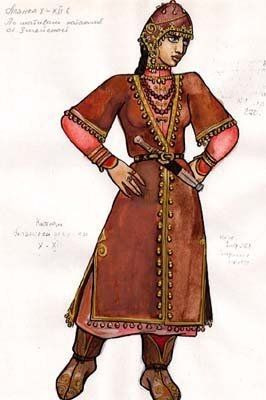
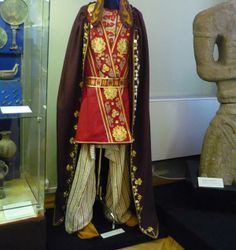
Does this style look familiar? Yeah, you can see the evolution/adaptation from this to later styles (bearing similarities) in Iran, India, Mongolia, the Baltics.
Cuz....y'know, that's where the proto Indo Europeans went about their biz and got jiggy with it and settled. Wow-wow-wee-wah! Okay now I'm done. Circular ish convo to get there but started with a fire goddess, it's relevant, but it all comes back to this.
Btw, this is also an important lesson for fantasy authors.
Because of all these connections and how old a bad ass fire goddess is, many of the oldest cultures are regarded as fire worshippers (like the Zoroastrians) did you know some keep an eternal burning flame? -- one is in Udvada Gujarat in India.
This flame has been said to have been kept burning for 1,500 years.
FIFTEEN HUNDRED.
And again, while most of the surviving Indo Iranic sun gods are male, there is evidence the ORIGINAL sun deity (including in/from the German, Baltic, and Slavic religions) was FEMALE.
#Tapati#sun god#sun goddess#Scythian culture#first gods were female#womens history#female history#proto indo european#indo european#Indian#Hindu#Baltic history#European history#deity worship#asian mythology#myths and legends#mythology#folklore#religions#religion changes things#ancient world#ancient history#ancient culture#did you know#fun fact#long thread#fantasy writers#fantasy authors#fantasy books#an important lesson
8 notes
·
View notes
Text


Loutrophoros (ritual vase), Greek (made in Italy), 300s B.C. Terracotta, 40 3/16 in. high. Antikensammlung, Staatliche Museen zu Berlin.
I found one more possible Scythian ancestral goddess on a vase, to go with my other post about Apulian vases.
#twin-tailed siren#mistress of animals#two tailed siren#ancient greek art#greek mythology#scythian ancestral goddess#potnia theron#ancient scythian art
188 notes
·
View notes
Text
Gold Headdress Ornament from Georgia (South Caucasus), c. 350-300 BCE: this stunning example of Colchian goldsmithing reflects a blend of influences from cultures throughout Europe and Asia

This headdress ornament was created in the ancient Kingdom of Colchis, which was located in what is now the nation of Georgia (nestled between Russia, Turkey, Armenia, and Azerbaijan, as this map illustrates). Much like modern Georgia, Colchis stood right on the boundary between the Eastern and Western worlds, with Europe on one side and Asia on the other; as a result, there are many Colchian (and Georgian) artifacts that combine the styles and techniques of various cultures from throughout Eastern Europe, the Caucasus, the Mediterranean, the Middle East, and Central Eurasia.
This is a particularly stunning example of that tradition.

From the Wine, Worship, and Sacrifice exhibition at NYU:
In technique and form, the piece is firmly rooted in local Colchian production. What makes the piece so fascinating, however, is its wide array of cultural influences.
Framed on three sides by rounded studs, the central area features a stylized stag and three smaller deer set around it––a motif also present in the gold work of the nomadic Scythians in the northwest. The piece’s openwork design recalls objects produced in Luristan in the southeast. Along the folded upper edge is a pair of outward-facing lions that, in composition, seem loosely related to Assyrian door guardians. Between them are three birds, a motif that occurs throughout ancient cultures, but which is particularly present in the goldwork at Vani.

The Colchians were famous for their skill as goldsmiths, and the Kingdom of Colchis was known as the homeland of the fabled Golden Fleece, as described in the Greek Argonautica.
There are many incredible pieces of goldwork that have been unearthed from Colchian sites, but this has always been one of my favorites.
Sources & More Info:
Institute for the Study of the Ancient World: Wine, Worship, and Sacrifice
J. Paul Getty Museum: Golden Graves of Ancient Vani
J. Paul Getty Museum: About Colchis and Vani
World History: Portion of a Colchian Headdress
#archaeology#artifact#history#ancient history#colchis#georgia#caucasus#vani#goldsmithing#art#ancient greece#mythology#greek mythology#jason and the argonauts#golden fleece#sakartvelo#kolkheti#gold#crafting#scythian#stag#ancient art#jewelry#goldwork
41 notes
·
View notes
Photo

Amazon Women
In Greek mythology, the Amazons were a race of warlike women noted for their riding skills, courage, and pride, who lived at the outer limits of the known world, sometimes specifically mentioned as the city of Themiskyra on the Black Sea. Their queen was Hippolyte, and although Homer tells us they were 'the equal of men', they most famously fought and lost separate battles against three Greek heroes: Hercules, Theseus, and Bellerophon. Scenes from these battles were popular in Greek art, especially on pottery and in monumental sculpture adorning some of the most important buildings in the Greek world, including the Parthenon of Athens. Intriguingly, archaeological investigation of tombs across Eurasia has shown conclusively that many women of nomadic steppe tribes were indeed warriors, particularly around the Black Sea area.
Origins & Name
In mythology, the Amazons were daughters of Ares, the god of war. They were members of a women-only society where men were welcomed only for breeding purposes and all male infants were killed. They were thought to dwell at the edge of what the Greeks considered their 'civilized' world and were most often associated with the area around the southern coast of the Black Sea, particularly the city-state of Themiskyra. Another Anatolian connection was at Ephesus, where it was thought Amazons had sacrificed to the goddess of hunting Artemis at her temple there and performed war dances, a ceremony repeated annually thereafter. Indeed, the foundation of many settlements in Asia Minor was credited to Amazons, notably Ephesus, Cyme, Sinope, Priene, Myrina, Smyrna, and Mytilene on Lesbos.
Herodotus (c. 484 – 425/413 BCE), writing in his Histories (Bk. 4, 110-117), gives a lengthy description of a meeting between Amazons and Scythians. Young warriors of the latter group persuaded a number of visiting Amazons to set up a new society together, with the women insisting neither they nor their offspring would change their lifestyles at all. This new race was considered the origins of the Sarmatians in southern Russia, appropriately enough, a people famous for their horses and military aggression.
Essentially, the society of the Amazons was thought of as Greek male-society in reverse and so they pursued such traditional male-dominated activities as horse-riding, hunting, and warfare. In legend (with no supporting historical evidence), the Amazons burnt off their right breast in order to better use a bow and throw a spear, indeed, the term a-mazon was popularly understood as meaning 'breastless', although alternative meanings include 'one breast' or 'not breast-fed.' Another alternative origin of the name is that it comes from Persian and means simply 'warrior.' One final interpretation is that the name derives from the Armenian, meaning 'Moon-goddess', and refers to priestesses of the Moon on the southern shores of the Black Sea who did, on occasion, bear arms. Interestingly, Amazons are not depicted in ancient Greek art with a missing breast. The historian Adrienne Mayor suggests that the literary confusion, therefore, comes from the similarity between mazon and the Greek word for breast mastos. In art, Amazons are most often depicted wearing hoplite armour and they frequently ride a horse. The most common weapons are the bow and spear, but there are also examples where Amazons carry axes. They were not only regarded as capable warriors but also particular experts at ambush and cavalry charges.
Continue reading...
93 notes
·
View notes
Text
While the ancient Greeks and therefore mythology had a massive lookism problem, there’s a surprising amount of monster romance with some important characters being descended from them:
Chrysaor was a boar monster and he married the beautiful nymph Calliroe.
Echion was a Spartoi, born from dragon’s teeth (so probably didn’t look like a normal dude) yet he married the princess Agave daughter of Cadmus.
Erichthonius was a snake man and the king of Athens (therefore the ancestor of Athenian nobility) and he married the nymph Praxithea.
Cecrops I was also a snake man and king of Athens and married Aglaurus.
And of course, Medusa was Poseidon’s lover.
In at least one source Hecate (who’s sometimes depicted as monstrous) was the mother of Scylla by Apollo
Edit: oh and Heracles with the Scythian snake woman! I can’t believe I forgot about them!
These are the ones I remember but I think there’s more.
#greek mythology#ancient greek mythology#greek pantheon#greek goddess#Greek god#monsters#Greek monsters#Gorgon#Spartoi#snake man
55 notes
·
View notes
Text

this is my special series masterlist, gods of the old and forgotten world (ateez edition) the series will consist of various mythology centered works that i’ll be releasing! this masterlist will be regularly updated as time goes on and i get more ideas on the whim. ( ◠‿◠ )
behold the eyes of old gods as they watch you, dear reader.


͙͘͡★Genre: Cosmic nostalgia, fantasy, fluff, cosmic deities, 1980's Hong Kong, episodical. non-linear story telling. Centered around the Chinese myth of “三星” Sanxing, The Three Star Gods
.͙͘͡★Pairings: Cosmic spirit/ Star child! San x Weary soul! childhood friend reader ͙͙͘͡★WC: 3.4k
͙͘͡★Summary: It’s the year 1982–Hong Kong’s once awe-inspiring neon lights are now a dull visage of what it once was for you in your youth. Drained and dreamless, you find yourself bawling in a telephone booth after every unanswered call until an old imaginary friend visits you at your lowest. You’re then thrusted into a strange and cosmic reality where the dreams of your youth weren’t so imaginary at all. (released, read here!)

ৡ Genre: Mythology, mythos horror, dark romance, hard smut, two-part series. Inspired by the Scythian sacrifices to the war god, Ares. (Ἄρης”)
ৡ Pairing: Fire god! seonghwa x sacrifice! reader
ৡ Summary: Seonghwa abhors humanity. The duality of his nature is apparent and it's more often than not that Seonghwa exposes his innately war-bound spirit. When he begins to craft an intricate plan to incite war upon humanity, a sudden sacrifice sent in dedication of appeasing the fire God disrupts the entire trajectory of his pointed sword.





.༄.° 𓃦 Genre: Mythology, angst, reincarnation trope, smut, tragedy, ambiguous era, one-shot. Centered around the Korean folklore myth of the "구미호”, the nine tailed fox and trickster spirit. (pronounced as ku-mi-ho)
.༄.° 𓃦 Pairings: Fox God! Wooyoung x reader
.༄.° 𓃦 Summary: The Fox Gods' temple has long since been abandoned by mankind. Wooyoung is a jaded God who’s slowly fading from existence amongst the overgrowth of his once lively and beloved temple when he meets you—a human with an uncanny ability to connect with wildlife. He is tested by the red strings of fate as your life falls into his hands—unaware of the fact that this is not the first life he's known you.
author’s note:
hi guys… siren, yet again. i’ve been on a creative high and have been actually making a lot of progress with both my new series and on the final chapters of all the others. this is the first multi-group fics series i’ve released. as always, since i’m the most comfortable with writing ateez this will be their designated masterlist as i start the series with them! next up will be enhypen and bts. somehow, i feel like writing a manuscript for a children’s story book after writing a faint signal! haha i keep writing new stories and my google docs looks like an emporium of some sorts now. such is the life of an insomniac and until i get meds—y’all will probably be getting lots of updates.
super psyched to write this and i am currently working on blood of the fire god. if anyone would like to be tagged when i update any of these, feel free to comment or send me a message! please like, comment, or reblog. <3
#ateez fanfic#ateez fanfiction#ateez x reader#ateez imagines#ateez smut#ateez#ateez angst#ateez seonghwa#kpop fanfiction#kpop fic#seonghwa x reader#seonghwa x you#seonghwa x y/n#seonghwa smut#seonghwa#wooyoung angst#wooyoung x reader#wooyoung#wooyoung fanfic#wooyoung smut#wooyoung x you#wooyoung x y/n#ateez wooyoung#ateez san#san ateez#san x reader#san fluff#san x you#san x y/n#san fanfic
47 notes
·
View notes
Text
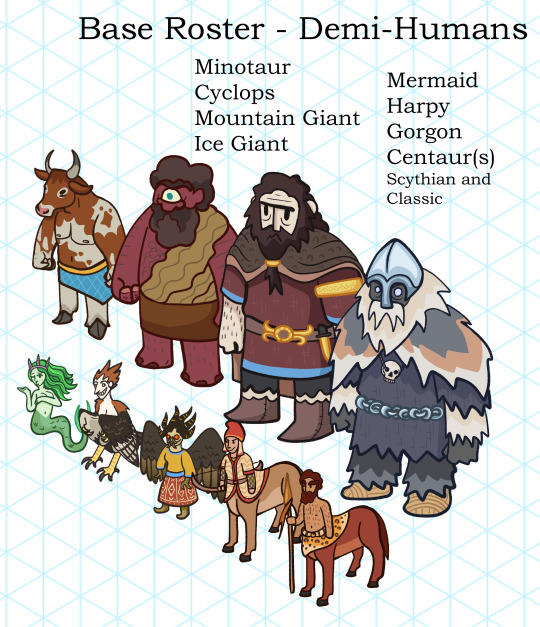
Behind the scenes I’ve been designing a table-top system based around collecting and battling with fantasy creatures. The actual creation of the system was fast, but the testing (still ongoing) and token design (above) have been progressing steadily. I took the opportunity to try out an isometric perspective for the base roster (a selection of monsters for the beta testing). After 67 drawings in this perspective I’m confident to say I’m not confident drawing in it. I’ll probably end up re-drawing most of these guys in a more conventional perspective for the actual game.
Despite that, I wanted to share the fruits of my labor. I didn’t draw 67 things just to not show them to people, even if I’m not very happy with them. Rather than showing all of them at the same time I divided them up into categories close to modern fantasy classifications for the sake of simplicity. Read beneath the cut for yapping (design notes):
Minotaur - The first proper Minotaur I've drawn and posted, as a matter of fact. It's based on the Minoan bull leaping fresco. His little skirt is also Minoan in design.
Cyclops - Just an isometric rendering of my design. He's a bit more conical in shape. Let's say this is intentional and so he's meant to look volcano-like.
Mountain Giant - This guy is your garden variety jotunn. A big fella. I wanted to demonstrate the dichotomy of jotnar in Norse mythology by showing them with both rough “barbarian” clothes and excessive amounts of gold. Norse giants are presented as both invaders at the door but also rich and wise, sometimes more so than the gods.
Ice Giant - In comparison to the mountain giant, the ice giant is all about business. And that business is fighting. His accessories are even more barbaric, replacing the gold with steel chains and a helmet. Plus a nifty skull necklace. He conforms to my frost giant designs being polar bear white with dark skin beneath.
Mermaid - Lately I’ve been looking back at my old art and seeing just how much I tried to subvert normal depictions of mythical creatures, but ended up making my own sort of dogma which I didn’t break from. My mermaids especially suffered from this, so I wanted to make a very earnest depiction. The crown of snail shells unintentionally makes her look like the Starbucks logo…
Harpy - Based in part on red-tailed hawks (for the color) and Skin Deep’s Anthony Gillis for the anatomy. Her hair is permanently like that due to flying at high speeds.
Gorgon - Just an isometric version of my older gorgon design. This was an early one and you can tell with the face. It’s much smaller and too scrunched up to make out what should be her defining attribute.
Centaur - A male based on an older drawing and a female based on ancient Scythians. These were made because a gender split does matter for some abilities in the game, but drawing different versions of every creature would be too much. So I just did it for the centaur for testing, which also demonstrates the different attacks they can use.
#mythical creatures#monsters#minotaur#cyclops#giant#mountain giant#ice giant#frost giant#jotunn#mermaid#harpy#gorgon#centaur
23 notes
·
View notes